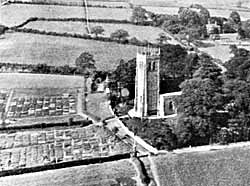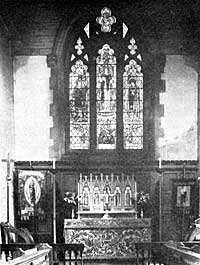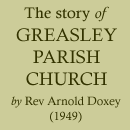 The church, vicarage and surrounding fields.
The church, vicarage and surrounding fields.RECENT ADDITIONS.
To complete our story of Greasley's Parish Church we must make mention of what has been done recently to adorn the building.
Two years after the end of the World War, the vicar launched an appeal for funds to set up a Memorial to the men of the parish who had laid down their lives in the cause of justice and freedom.
It was felt that this memorial should in some way be linked up with that of the 1914-1918 War, but no decision could be made as to the form it should take until some indication appeared of the amount of money likely to be forthcoming.
The general feeling seemed to be in favour of a stained glass window, and as the Parish Church had no such windows, this idea caught the imagination of the parishioners. It was rightly thought that a fine window of original and striking design in the east end would make a tremendous addition to the beauty of the chancel; moreover, with the existing memorial screen at the chancel steps, the chancel would then form a war memorial chapel.
In just over a year £968 was raised in the parish, all by direct giving, for this purpose, and on Sunday, October 31st, 1948, the Lord Bishop of Southwell dedicated the new East Window.
 The 1939-1945 War Memorial East Window and
Reredos.
The 1939-1945 War Memorial East Window and
Reredos.DESCRIPTION OF THE EAST WINDOW.
When considering the design for the window it was thought undesirable to portray anything of the nature of modern warfare. The proportions of the three main panels suggested a single-figure treatment; accordingly, the figure of Our Lord occupies the central panel as the supreme example of self-sacrifice. With the nail wounds showing in His hands and feet, he is offering to all mankind (represented by the world on which He is standing) His blessing and His peace. "My peace I give unto you." (St. John, ch. 14, v. 27). Clouds surround the world .suggesting men's sins, doubts and fears. Above the figure of Christ are two devotional angels holding a crown of glory, symbolical of heavenly reward for faithful earthly service.
In the base of the centre panel is portrayed Saint Michael the Archangel conquering evil, shown in the traditional form of a dragon. "And there was war in heaven: Michael and his angels fought against the dragon; and the dragon fought and his angels, and prevailed not; neither was their place found any more in heaven" (Revelation, ch. 12, v. 7, 8). This symbolises the victory of the Battle of Britain.
The badge of the Royal Air Force is designed into the topmost piece of tracery.
The left panel shows St. George, Patron Saint of England, and of soldiers, against a fortressed background: one hand holds a banner, on which is the red cross of Saint George, and the other holds a shield bearing the heraldic lions of England.
The sheathed sword and wreath of honour occupy the base of this panel, and in the tracery above is the recently issued badge of the British Army.
The right panel depicts Saint Nicholas, a 4th century Bishop of the Church and Patron Saint of sailors. He is seen with his pastoral staff, against a background of sea and a ship.
In the base of this panel is an anchor, and in the tracery above is the badge of the Royal Navy.
Intertwined conventional roses and oak leaves frame and unite the three panels.
The window bears the inscription: "In remembrance of the men of this parish who gave their lives in the World War, 1939-1945."
The names of the Fallen, 26 in number, are carved on an Oak Tablet fixed to the north wall of the Chancel. The Tablet has this inscription: "Greater love hath no man than this, that a man lay down his life for his friends" (St. John, ch. 15, v. 13.)
In view of the magnificent response to the War Memorial Fund, the scheme was extended further to beautify the chancel by the insertion of stained glass in the other two windows on the south side, and by improving the reredos of carved stone which, set up in 1896, had become dirty, dull, and drab.
This work was carried out by the same craftsman (H. T. Hincks, Nottingham) who had designed and made the East Window. The windows have been named the "Beauvale Priory Window" and the "Diocesan Window."
THE BEAUVALE PRIORY WINDOW.
The design of the window was built up around the two roundels of ancient painted glass taken from the living-room window of the old Beauvale Manor Farm (opposite the Priory ruins) and presented to our Parish Church. When they were placed there, and by whom, is not known, but we can rejoice that these historic relics of Beauvale Priory have been preserved for 400 years and are now in the safe keeping of the Church. A bronze tablet underneath the window tells their story: —
"These roundels of ancient glass, representing St. Lucy and St. Agatha, were once in Be3uvale Charterhouse in this parish. After the dissolution of the Priory in 1540, they passed into secular hands, but were recovered and placed here in 1947."
In addition, the window contains: (1)The coat of arms and crest of Nicholas de Cantelupe, the founder of the Priory. On a shield are three leopards' faces in reverse, the Cantelupe arms. It is interesting to note that there is a fine effigy of the grandfather of the founder of the Priory (also named Nicholas) in the chancel of Ilkeston Parish Church, and his shield bears the Cantelupe arms; also the arms of the Diocese of Hereford are almost exactly the same as the Canlelupe. (Thomas de Cantelupe was Bishop of Hereford in 1275); (2) The coat of arms, surmounted by a mitre of William la Zouch, Archbishop of York, and cousin of Nicholas, who confirmed the charter of foundation as diocesan bishop; (3) The common seal of the Priory. This has been taken from a wax impression of the seal attached to the Deed of Surrender in the British Museum. It shows our Lord seated in a canopied niche, lifting up the right hand in benediction; below is the figure of a monk, kneeling in prayer; (4) A representation of the Priory ruins as seen to-day; (5) The Blessed Virgin and Child; (6) An inscription, "Beauvale Charterhouse was founded December 9th, 1343, by Nicholas de Cantelupe, of Greasley Castle, with the consent of his cousin, William la Zouch, Archbishop of York. The Prior and Monks were the patrons of this Church until the Priory was surrendered to the King, July 18th, 1540."
THE DIOCESAN WINDOW.
This window contains shields (surmounted by mitres), bearing the arms of the Dioceses of York, Lincoln and Southwell, and roundels with the three Minsters. The inscription reads: "From ancient time Nottinghamshire with the Minster of Southwell was included in the Diocese of York. In 1837 the county and its churches were transferred to the Diocese of Lincoln. In 1884 the Diocese of Southwell was created."
THE REREDOS.
The carving on the stone reredos has been "picked out" in colour, and painted wooden panels inserted in the five niches. The centre panel shows our Lord holding a chalice, while the other panels portray the four Evangelists—St. Matthew, St. Mark, St. Luke and St. John.
